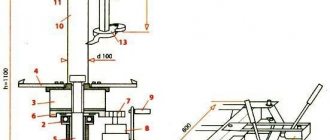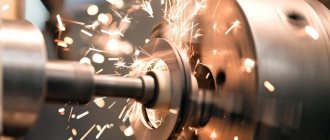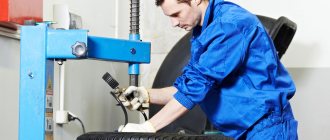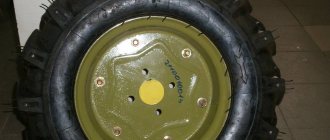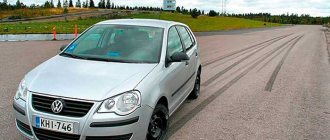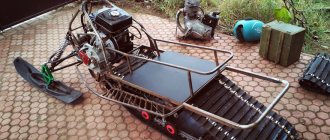What is wheel balancing
If all the other shafts and rotating parts work in a closed volume and they absolutely do not care what happens outside the crankcase, block or housing, then the wheels have a hard time. Even if the tire and disk assembly are perfectly balanced, during operation anything can happen to them, from deformation to the accumulation of dirt. All this affects the balancing of the wheel. What is this, balancing?
Balancing a car wheel is all about eliminating radial mass differences. That is, if the wheel is lighter on one side and heavier on the other, then it will vibrate when rotating. The higher the rotation speed, the greater the vibration.
How to balance a driveshaft yourself
Based on the information received, it is clear that without special equipment there can be no talk of any precise balancing. However, if a situation arises where it is necessary to carry out balancing, but there is no such workshop nearby, as a temporary measure you can do the following:
the cardan is conventionally divided in the longitudinal plane into 6-8 parts;
a weight (15-30 g) is attached to each of the sectors in turn; this can be a weight for balancing wheels;
the car is taken out onto a flat road and a check is carried out to determine whether the vibration has been eliminated or has become even greater;
After this, the cargo is moved to another sector.
It is clear that this method will only remove the main imbalance and in no way claims to be accurate, but it will allow you to get rid of vibrations for a while and get to the service station. Make sure the rotating parts are balanced and enjoy your travels!
Why and how often to do balancing
Needless to say, constant vibration on the steering wheel even at the lowest speeds is simply unacceptable. Wheel imbalance leads to:
- deterioration of wheel adhesion to the road;
- rapid wear of tires, chassis and car suspension;
- a sharp deterioration in controllability;
- deterioration of the brake system.
Read also: Do-it-yourself tire shredder
Balance the wheels if necessary, when vibrations occur, as well as after replacing tires, after repairing them and vulcanizing the tubes, after straightening or rolling out steel wheels.
In addition to safety, reduced service life and high fuel consumption, wheel imbalance does not bring much comfort to the car interior. Therefore, balancing wheels with your own hands should become a habitual procedure for every motorist. At least in order to understand how and how this is done.
When it is necessary?
Experts identify several basic requirements regarding wheel balancing.
This work must be performed in the following cases:
- When replacing tires from winter to summer (and vice versa). Usually, at normal service stations, when “re-shoeing” a car, balancing is done immediately and is included in the cost of the service. If you change the tires yourself, you will also have to do the balancing work yourself;
- In case of hitting a curb, falling into a hole or passing a concrete policeman at speed. Such situations rarely end without a trace for the car's drive. Even a minimal defect can lead to wheel imbalance. Therefore, contacting a tire service is also mandatory;
- Every 15,000 kilometers. Few car enthusiasts cover such a distance within one year, so balancing when changing tires seasonally is sufficient. But there are also “truck drivers” who have to do this work twice a year;
- Every 7000-8000 kilometers – for those who like fast and aggressive driving;
- Before a long trip (1.5-2 thousand kilometers and above) and after it. This requirement is based on safety reasons.
Types of imbalance
And in order to understand the methods of balancing, you need to know the enemy in person, that is, imbalance. Taking into account the simple laws of physics, one can guess that imbalance can be of two types - dynamic and static.
- Static imbalance occurs when the wheel's center of gravity moves away from the axis of rotation. The simplest type of imbalance and do-it-yourself wheel balancing is most often aimed at eliminating static imbalance. The wheel vibrates up/down.
- Dynamic imbalance is the case when it can only be caught when the wheel rotates, and at fairly high speeds, close to operating conditions. This type of imbalance is characterized by a displacement of the center of gravity of the wheel not only beyond the axis of rotation, but also by an uneven displacement of several centers of gravity relative to each other in a perpendicular plane. The wheel wobbles and vibrates. The diagram will explain this more simply.
It turns out that it is not for nothing that every tire shop has stands for wheel balancing, since any vulcanization is, although minimal, a shift in the center of gravity of the entire wheel, which must be balanced. The cost of balancing wheels on a machine is pennies, but if it is not done, the consequences can be the most depressing.
What is the danger?
It would seem that what can happen if wheel balancing is not done in a timely manner? We often forget that each wheel has its own individual weight, pressure, technical characteristics, oval shape and defects. Therefore, the issue of balancing it is very important.
If this is not done, the consequences may be as follows.
The braking distance of the car increases.
This is easy to explain - the contact area between the tire and the asphalt decreases, grip deteriorates, and traffic safety decreases.
The reasons are the same as in the previous case.
There is a beating in the steering wheel.
The imbalance in the wheel is transmitted to the suspension, and then to the steering wheel. The stronger it is, the greater the vibrations the driver feels. In this case, driving a car is very dangerous.
Suspension wear accelerates.
Poor balancing (or lack thereof) most affects the suspension bearings and hubs. Due to imbalance, these elements of the chassis system may even collapse. The result is loss of controllability and the likelihood of an accident.
Increased tire wear.
The reasons are uneven distribution of forces and the appearance of vibration. Essentially, the tires will be “eaten up” on one side.
DIY wheel balancing technology
The simplest and most accessible method of static balancing is available to anyone who is able to hang a car on a jack. Moreover, it is recommended to check wheel balancing after each wheel replacement, regardless of whether it has been balanced before or not. And it couldn’t be easier to do this.
- The car is hung on a jack, after which one of the wheels should rotate freely on the hub.
- The wheel spins slightly, if the brake pads are in the way, you need to negotiate with them so that they do not prevent the wheel from rotating completely freely. The same goes for the wheel bearing. Sometimes it becomes necessary to let it go, and after balancing, do not forget to tighten it again.
- The wheel rotates freely in one direction, and the place that will be at the bottom is marked with chalk. The wheel spins in the other direction. The corresponding mark is placed again. And so - several times. If the marks never coincide, the wheel does not need static balancing.
- Otherwise, a weight is installed on the side of the wheel diametrically opposite the mark. The mass of the weight is selected empirically, since the exact weight of the weight cannot be determined by eye. Only a tire balancing stand can do this.
Read also: DIY liquid fuel burner
Congratulations. The static balancing of one of the wheels is completed, now you can begin balancing the rest. Upon completion, sea trials must be carried out. As a rule, an unbalanced wheel begins to vibrate at a speed of about 70-90 km/h.
By the way, the simplest balancing machine can be assembled around an old hub in which the bearing has not yet died. You just have to install the homemade stand perfectly evenly in all planes. Balanced wheels for all and a pleasant driving experience!
Balancing machines detect irregularities on parts during rotation and help eliminate them. Most often, devices with this operating principle are used in tire shops. In addition, these devices have found application in the mechanical engineering industry, where they help balance propellers, turbines and other parts.
Such devices may be equipped with equipment to automatically correct irregularities. In this article we will talk about calibrating a balancing machine with our own hands and describe its structure.
Conclusion
Remember that wheels need periodic balancing, and the technical condition of the vehicle and your health directly depend on this.
You need to understand that self-balancing wheels does not give an accurate result, only modern high-tech equipment can give an ideal result, and you can only find it in a good car service center.
Draw conclusions and be careful on the roads. Good luck.
Reading time: 7 minutes
During tire fitting, new tires do not always fit perfectly. Even microscopic errors and errors in the distribution of mass balance at high speed can cause severe runout. As a result of such an impact, the driver experiences discomfort, feeling vibration in the steering wheel, while the suspension wears out greatly and can quickly become unusable. To avoid such troubles, the range of services at a service station always includes wheel balancing.
Structure of the apparatus
The basis of a balancing machine is the supports on which the workpieces and sensors are installed to determine their balance. During testing, the level of imbalance is determined, and based on this information, further actions are taken.
Depending on the type of support, balancing machines are divided into soft and hard. The first measure the parameters of the wheel, taking into account the vibrations of the supports. At the same time, the device is additionally configured for each detail, which allows for fairly accurate testing.
In both the first and second versions of the device, the speed sensor plays a special role. No less important for such a machine is the sensor that measures the rotation angles. Depending on the information input option, balancing devices can be manual or automatic.
Balancing the crankshaft at home
Basically, at home, the crankshaft and flywheel are balanced. To do this, it is also necessary to determine the heaviest point. This is done as follows: two T-shaped plates are installed, naturally level, and the part is placed on top of them. If unbalanced, the crankshaft will roll until its heaviest point is in the down position. Thus, the place from which it is necessary to remove some metal is determined. This procedure should be repeated until complete equilibrium is achieved.
If we are talking about new cars, then in this case you need to resort to the modular assembly method, when all elements are balanced separately, and not assembled. But it is better to entrust the implementation of this procedure to professionals, especially since, basically, such machines are under warranty service, and you should not neglect it
It is not so important where to balance the crankshaft, the main thing is to remember that this procedure will significantly increase the service life and power of the engine, and the car as a whole
To save costs on maintenance at a car service center, you can balance the crankshaft in a garage. The article describes options on how you can balance the crankshaft yourself.
When the crankshaft is unbalanced, the mass is distributed unevenly along and across the axis, that is, the balance is upset: one edge is lighter than the other. The main cause of lateral imbalance is wear of shaft parts during prolonged use.
Crankshaft balancing is carried out to reduce the load and vibration on the components of the power unit. This operation makes it possible to increase engine performance and extend service life. Basically, balancing is necessary for worn-out engine elements, but there are cases when a new car needs balancing.
Balancing the crankshaft in the garage
You can determine whether the crankshaft needs balancing by the behavior of the gear shift knob: it begins to wobble when idling. The same goes for the engine: if at idle the engine runs jerkily.
The causes of problems may be different:
- poor quality manufacturing of associated parts;
- heterogeneity of the material used for the crankshaft;
- backlashes resulting from violation of the gaps between mating elements;
- poor quality assembly;
- inaccurate centering;
- natural wear and tear.
After replacing the flywheel or its ring gear, the clutch basket, it is necessary to balance the crankshaft. If this procedure is not followed, then even at low speeds the motor will begin to vibrate due to imbalance.
There are two ways to balance the crankshaft:
- The static method is used for minor imbalances. In this case, the crankshaft is stationary. In this case, the heavy side is lowered down. The light side is balanced using weights that are attached to the edge of the light side. Then, using special knives, the metal is removed from the heavy part until the loaded part is lowered.
Grinding the crankshaft
The dynamic method is more accurate than the static one. It is used to correct a significant imbalance. In this case, a special machine is needed on which the shaft is installed. The crankshaft begins to spin to the required speed. Using a laser, the point where the heaviest point is located is determined. Excess metal is removed from this place.
Principle of operation
The main task of the balancing machine is to determine the balance of the geometric center of the wheel with its mass. An unbalanced part makes any job difficult and can lead to serious damage. Eliminating imbalance allows you to:
- Increase the service life of bearings.
- Prevent premature wear of tires.
- Increase the service life of suspensions.
There are several options by which you can correct imbalance of wheels or other parts:
- Balancing rings - used in the process of repairing metalworking machines.
- Adjusting screws - special pins are screwed into the unbalanced part, through which it is adjusted.
- Drilling is the most popular balancing option. This is done by creating holes that change the weight of the parts being processed.
Read also: Magstrong 450 drilling and tapping
Balancing machine repair
After prolonged use, individual parts of the device may malfunction. Conventionally, the origin of the breakdown can be divided into mechanical disorders and problems with electrical components. In the latter case, problems with the sensors are detected. Mechanical problems most often occur after falls or strong impacts.
Problems with the machine can be detected by the following signs:
- Normal balancing requires several cycles of operation.
- The parameters of the tested disks are determined incorrectly.
Homemade device
It is possible to make a calibrating machine at home, but only the mechanical part. Electrical equipment and measurement sensors should be purchased ready-made. The device drawings should be selected in accordance with the features of the future use of the machine. The best option for creating a balancing machine is presented in these step-by-step instructions:
- We create a shaft. It should be turned so that at one end there is a ready-made place for mounting bearings, and at the other there is a thread for installing a washer.
- We install bearings. It is best to use those that have already been used, but have not yet used up the main resource. Such parts will create minimal resistance.
- We form the apparatus stand. For these purposes, it is best to use a pipe with a diameter of 5.2 centimeters. At the upper end of the support we mount it from above and from the side.
- For convenient placement of the part, we recommend creating a support platform.
Video: DIY wheel balancing machine.
Stories from our readers
“Fucking basin. "
Hi all! My name is Mikhail, now I’ll tell you a story about how I managed to exchange my two-wheeler for a 2010 Camry. It all started with the fact that I began to be wildly irritated by the breakdowns of the two-wheeler, it seemed like nothing serious was broken, but damn it, there were so many little things that really started to irritate me. This is where the idea arose that it was time to change the car to a foreign car. The choice fell on the melting Camry of the tenth years.
Yes, I had matured morally, but financially I just couldn’t handle it. I’ll say right away that I am against loans and taking a car, especially not a new one, on credit is unreasonable. My salary is 24k a month, so collecting 600-700 thousand is almost impossible for me. I started looking for different ways to make money on the Internet. You can’t imagine how many scams there are, what I haven’t tried: sports betting, network marketing, and even the volcano casino, where I successfully lost about 10 thousand ((The only direction in which it seemed to me that I could make money was currency trading on the stock exchange, they call it Forex. But when I started delving into it, I realized that it was very difficult for me. I continued to dig further and came across binary options. The essence is the same as in Forex, but it’s much easier to understand. I started reading forums, studying trading strategies. I tried it on a demo account, then opened a real account. To be honest, I didn’t manage to start earning money right away, until I understood all the mechanics of options, I lost about 3,000 rubles, but as it turned out, it was a precious experience. Now I earn 5-7 thousand rubles a day. I managed to get the car buy after half a year, but in my opinion this is a good result, and it’s not about the car, my life has changed, I naturally quit my job, I have more free time for myself and my family. You’ll laugh, but I work directly on the phone)) If If you want to change your life like me, then here’s what I advise you to do right now: 1. Register on the site 2. Practice on a Demo account (it’s free). 3. As soon as you get something on the Demo account, top up your REAL ACCOUNT and go to REAL MONEY! I also advise you to download the application to your phone, it’s much more convenient to work from your phone. Download here.
Procedure:
- Install the wheel on the hub.
- Spin the wheel clockwise.
- We observe the moment when the wheel begins to stop. If it sways from side to side, then there is an imbalance and the wheel needs to be balanced.
- When the wheel has stopped, place a vertical mark on the upper center of the wheel.
- Spin the wheel counterclockwise.
- When the wheel has stopped, place a vertical mark on the upper center of the wheel.
- We determine the center between the two marks and install a weight in this place.
- We repeat the procedure from point No. 2 until the wheel is balanced.
The last video demonstrates a modified wheel balancing machine. To determine the weight of the weight being installed, a special balancer is used:
Now you know how to check wheel balancing yourself. Have you ever used such methods? Which of these balancing methods is better?
Have you ever had to balance wheels yourself?
Many car enthusiasts underestimate the importance of wheel balancing, considering such a popular event a waste of money. But this is a big mistake.
Such an attitude can lead not only to costs in the future, but also to a serious accident with unpredictable consequences.
Remember that timely wheel balancing is one of the main tasks for any driver. Moreover, we will look at how, when and why this is done in the article.
Nuances of operation
To start working with the machine, you need to fix the disk. This can be done using a nut and a cone. After checking the reliability of the fastening, you can begin measuring procedures. The disk is spun up, and then its performance is compared with the reference ones. Deviations should be in the range of 2 and 1.5 g. The first indicator is horizontal, the second is radial.
After the initial testing, all weights should be removed and repeated measurements should be taken. The disc under test stops at the heaviest point downwards. Be sure to take this information into account when measuring disk parameters. After this, the wheel must be twisted 90 degrees and a load is hung on the opposite side. If the wheel stops rotating when turned 45 degrees, it means that the do-it-yourself calibration was done successfully.
Application of static balancing
Static balancing of impellers is an effective means of reducing vibration, bearing loads and increasing machine durability. But it is not a panacea for all ills. In “K” type pumps, you can limit yourself to static balancing, but for the rotors of “KM” monoblock pumps, dynamic balancing is required, since there is a mutual influence of unbalances of the wheel and the electric motor rotor. Dynamic balancing is also necessary for electric motor rotors, where the mass is distributed along the length of the rotor. For rotors with two or more wheels that have a massive coupling half (for example SE 1250 - 140), the wheels and coupling are balanced separately, and then the rotor assembly is dynamically balanced. In some cases, to ensure normal operation of the mechanism, dynamic balancing of the entire unit in its own bearings is necessary.

